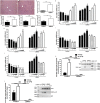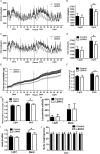Hepatic estrogen receptor α is critical for regulation of gluconeogenesis and lipid metabolism in males
- PMID: 28490809
- PMCID: PMC5431852
- DOI: 10.1038/s41598-017-01937-4
Hepatic estrogen receptor α is critical for regulation of gluconeogenesis and lipid metabolism in males
Abstract
Impaired estrogens action is associated with features of the metabolic syndrome in animal models and humans. We sought to determine whether disruption of hepatic estrogens action in adult male mice could recapitulate aspects of the metabolic syndrome to understand the mechanistic basis for the phenotype. We found 17β-estradiol (E2) inhibited hepatic gluconeogenic genes such as phosphoenolpyruvate carboxykinase 1 (Pck-1) and glucose 6-phosphatase (G6Pase) and this effect was absent in mice lacking liver estrogen receptor α (Esr1) (LERKO mice). Male LERKO mice displayed elevated hepatic gluconeogenic activity and fasting hyperglycemia. We also observed increased liver lipid deposits and triglyceride levels in male LERKO mice, resulting from increased hepatic lipogenesis as reflected by increased mRNA levels of fatty acid synthase (Fas) and acetyl-CoA carboxylase (Acc1). ChIP assay demonstrated estradiol (E2) induced ESR1 binding to Pck-1, G6Pase, Fas and Acc1 promoters. Metabolic phenotyping demonstrated both basal metabolic rate and feeding were lower for the LERKO mice as compared to Controls. Furthermore, the respiratory exchange rate was significantly lower in LERKO mice than in Controls, suggesting an increase in lipid oxidation. Our data indicate that hepatic E2/ESR1 signaling plays a key role in the maintenance of gluconeogenesis and lipid metabolism in males.
Conflict of interest statement
The authors declare that they have no competing interests.
Figures





Similar articles
-
Mechanism of oestrogen and progesterone effects on lipid and carbohydrate metabolism: alteration in the insulin: glucagon molar ratio and hepatic enzyme activity.Eur J Clin Invest. 1977 Jun;7(3):181-7. doi: 10.1111/j.1365-2362.1977.tb01595.x. Eur J Clin Invest. 1977. PMID: 19260
-
Hepatic glucose intolerance precedes hepatic steatosis in the male aromatase knockout (ArKO) mouse.PLoS One. 2014 Feb 10;9(2):e87230. doi: 10.1371/journal.pone.0087230. eCollection 2014. PLoS One. 2014. PMID: 24520329 Free PMC article.
-
Berberine Attenuates Development of the Hepatic Gluconeogenesis and Lipid Metabolism Disorder in Type 2 Diabetic Mice and in Palmitate-Incubated HepG2 Cells through Suppression of the HNF-4α miR122 Pathway.PLoS One. 2016 Mar 24;11(3):e0152097. doi: 10.1371/journal.pone.0152097. eCollection 2016. PLoS One. 2016. PMID: 27011261 Free PMC article.
-
HNF-4α regulated miR-122 contributes to development of gluconeogenesis and lipid metabolism disorders in Type 2 diabetic mice and in palmitate-treated HepG2 cells.Eur J Pharmacol. 2016 Nov 15;791:254-263. doi: 10.1016/j.ejphar.2016.08.038. Epub 2016 Aug 31. Eur J Pharmacol. 2016. PMID: 27592052
-
Role of Estrogens in the Regulation of Liver Lipid Metabolism.Adv Exp Med Biol. 2017;1043:227-256. doi: 10.1007/978-3-319-70178-3_12. Adv Exp Med Biol. 2017. PMID: 29224098 Free PMC article. Review.
Cited by
-
Yap signalling regulates ductular reactions in mice with CRISPR/Cas9-induced glycogen storage disease type Ia.Anim Cells Syst (Seoul). 2022 Nov 7;26(6):300-309. doi: 10.1080/19768354.2022.2139755. eCollection 2022. Anim Cells Syst (Seoul). 2022. PMID: 36605584 Free PMC article.
-
Estrogen Signaling Induces Mitochondrial Dysfunction-Associated Autophagy and Senescence in Breast Cancer Cells.Biology (Basel). 2020 Apr 1;9(4):68. doi: 10.3390/biology9040068. Biology (Basel). 2020. PMID: 32244623 Free PMC article.
-
Effects of ERβ and ERα on OVX-induced changes in adiposity and insulin resistance.J Endocrinol. 2020 Apr;245(1):165-178. doi: 10.1530/JOE-19-0321. J Endocrinol. 2020. PMID: 32053493 Free PMC article.
-
Estrogen Receptor-α Suppresses Liver Carcinogenesis and Establishes Sex-Specific Gene Expression.Cancers (Basel). 2021 May 13;13(10):2355. doi: 10.3390/cancers13102355. Cancers (Basel). 2021. PMID: 34068249 Free PMC article.
-
Estrogen Improves Insulin Sensitivity and Suppresses Gluconeogenesis via the Transcription Factor Foxo1.Diabetes. 2019 Feb;68(2):291-304. doi: 10.2337/db18-0638. Epub 2018 Nov 28. Diabetes. 2019. PMID: 30487265 Free PMC article.
References
Publication types
MeSH terms
Substances
Grants and funding
LinkOut - more resources
Full Text Sources
Other Literature Sources
Molecular Biology Databases
Research Materials
Miscellaneous

